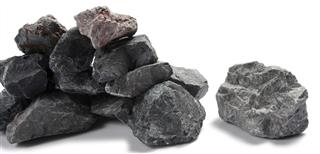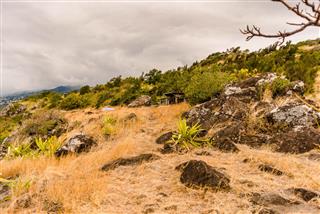
Andesite is an extrusive igneous rock that has a porphyritic texture. This rock is formed from molten magma, which has medium viscosity. Read this ScienceStruck article to know the facts, origin, formation, and properties of andesite rocks.
What type of a rock is andesite?
- Volcanic
- Igneous
- Porphyritic
- Extrusive
The amount of silica contained in any rock determines its chemical composition. Geologists use this measure to identify rocks and understand their characteristics. While granite is known to be rich and basalt or rhyolite to be poor in their silica content, andesite rock is said to be having silica content, intermediate to these rocks.
The name ‘andesite’ is derived from a mountain range, the Andes in South America. These rocks are formed due to the constant subduction processes that lead to pushing of tectonic plates downward along the continental margins.
Formation of the Andesitic Rocks
Let us now understand the process of formation of andesite rocks. At times, magma crystallizes into rocks and certain minerals get removed from the rock once the process of crystallization is over. This after a certain point of time results in the formation of andesite. In some instances, magma in the molten form moves in the upward direction towards the predominant crust. When molten magma comes in contact with the crustal portion, it tends to melt it. The partial melting of the crust leads to the creation of andesitic magma. The magma that is generated from the above two sources fuses to form these types of rocks.

Andesite Rocks Found at Romania

Andesite Rocks Used in Mitad del Mundo Globe

Andesite Rocks in Slovak Republic
Where is Andesite Rock Found?
The rock derives its name from Andes mountain ranges, which possess a large number of andesite rocks. Besides this mountain range, the Cordillera mountain range of North and Central America houses these rocks too.
In New Zealand, it is found in Raglan-Kawhia area, Coromandel Peninsula, Great and Little Barrier Islands, West Auckland, Western Bay of Plenty, Central North Island, and Taranaki. A few active volcanoes include Popocatépetl (Mexico), Mount Ngauruhoe (New Zealand), Mount Shasta (U.S.), Mount Adams (U.S.), Soufrière Saint Vincent (Caribbean), Krakatoa (Indonesia), Mount Fuji (Japan), Montagne Pelée (Caribbean), Bandai-san (Japan), and Mount Hood (U.S.).
Furthermore, this rock was also found in two space meteorites in the year 2009 in the Graves Nunatak Icefield during a meteorite search. Other examples can be peperino volcanic tuff located at Rome (Italy), or the trass volcanic tuff located at Eifel district (Germany).
Characteristics and Properties of Andesite Rock
- Andesite consists of plagioclase feldspar along with pyroxene. In addition to this, it may contain hornblende.
- The auxiliary minerals that this rock may contain are apatite, garbet, ilmenite, biotite, magnetite, zircon. It may contain trace amounts of alkali feldspar as well.
- It is moderate in its silica content. That is, it is neither rich nor deficient in this mineral. The silica content is 50-65%.
- The density of this type of rocks is 2.11 – 2.36 g/cm3.
- It has a porphyritic texture. The term ‘porphyritic’ means inclusion of large-size crystals in a fine-grained rock.
- The specific gravity of this rock is 2.5 – 2.8.
- It generally occurs in the hues of gray. However, it is lighter in color than basalt.
- It is said to form thicker fluxes or dome-shaped structures.
- The hardness of andesite rock on Moh’s scale is 7.
Uses of Andesite Rock
1) It finds its chief uses in the construction and road-making industries for making roadbeds. It is used as a filler or sometimes added as a constituent to various compounds.
2) It is used in making statues and monuments. Besides this, it is used in designing landscapes and gardens.
3) Its resistance to slip makes it very apt to be used in making tiles.
Facts About Andesite Rock
- This rock is considered to be the volcanic equivalent of diorite, which is a granular crystalline rock.
- They result from the formation of lava and thus, belong to the volcanic category of rocks.
- Our continental crust is largely made up of these rocks.
- It is named based on its composition. The mineral highest in value is considered first, while naming the rock.
- The darker varieties of these rocks are sometimes mistaken as basalt rocks.
- These rocks are mainly found near volcanoes, which demarcate the Pacific Ocean.

